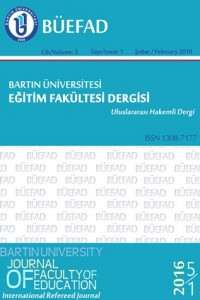Yabancı Dil Öğretiminde Otantik Materyal Kullanımı (Using Authentic Materials in Foreign Language Teaching) Doi: 10.14686/buefad.v5i1.5000158999
Abstract
Yabancı dil öğretiminde materyal kullanımı çok önemli ve başarıyı arttıran bir unsurdur. Gelişen teknoloji sayesinde, kullanılan materyallerin çeşidinde ve niteliğinde önemli ilerlemeler olmaktadır. Bu materyallerin bir çeşidi olan otantik materyaller, yabancı dil öğretiminde en çok tercih edilebilecek materyallerdir. Alan yazın taraması niteliğindeki bu çalışmada, yabancı dil öğretiminde otantik materyallerin kullanılması ve seçilmesi konularında birçok önemli noktaya değinilmektedir. Öncelikle otantik materyallerin tanımı yapılmakta ve diğer materyallerden nasıl ayrılacağı konularından bahsedilmektedir. Daha sonra, farklı otantik materyal türleri ele alınmaktadır. Makalemizde ele alınan başka bir nokta ise otantik materyallerin kullanımının alan yazında bulunan çok sayıda avantajı ve dezavantajıdır. Bu çalışmayı önemli kılan en önemli nokta ise otantik materyallerin seçiminde dikkat edilmesi gereken konulara değinilmesidir. Böylece yabancı dil öğretiminde doğru seçilen otantik materyaller sayesinde eğitimciler olarak çok daha başarılı olabiliriz.
References
- Adams, T. (1995). What Makes Materials Authentic? ERIC Document Reproduction Service No. ED 391389.
- Al Azri, R. H. & Al-Rashdi, M. H. (2014). The effect of using authentic materials in teaching.
- Internatıonal Journal of Scıentıfıc and Technology Research, 3(10), 249-254. Berardo, S. A. (2006). The use of authentic materials in the teaching of reading. The reading matrix, 6(2), 60-69.
- Dale, E. (1969). Audio-visual methods in teaching (3rd ed). New York: Dryden.
- Genhard, J. G. (1996). Teaching English as a foreign language: A teacher self-development and methodology. Ann arbor: the University of Michigan Press.
- Harmer, J. (1994). The Practice of english language teaching. London: Longman.
- Herod, L. (2002). Adult learning from theory to practice. Heinle and Heinle Publishers. Heinemann.
- Kilickaya. F. (2004). Authentic materials and cultural content in EFL classrooms. The Internet TESL
- AutenticMaterial.html], Erişim tarihi: 20.12.2014. (7), Çevrim-içi. http://iteslj.org/Techniques/Kilickaya
- Laniro, S. (2007). Authentic materials. M. A. Corley ve P. Esra (Eds), Professional Development
- Fact Sheet, American Institutes for Research. Larimer, R. E. & Schleicher, L. (Eds.). (1999). New ways in using authentic materials in the classroom. Alexandria, VA: TESOL.
- Lee, W. (1995). Authenticity revisited: Text authenticity and learner authenticity. ELT Journal, (4), 323-328.
- McGrath, I. (2002). Materials Evaluation and design for language teaching. Edinburgh:
- Edinburgh University Press Ltd. Miller, L. (2003). Developing listening skills with authentic materials. ESL Magazine, 6 (1), 16
- Miller, M. (2005). Improving aural comprehension skills in EFL, using authentic materials: an experiment with university students in Nigata, Japan. Unpublished master‘s thesis,
- University of Surrey, Australia. Newby, D. (2000). Authenticity. A. Fennar ve D. Newby (Eds), Approaches to materials design in European textbooks: Implementing principles of authenticity, learner autonomy, cultural awareness, Autria, Council of Europe.
- Nunan, D. (1999). Second language teaching and learning. Boston: Heinle and Heinle Publishers.
- Otte, J. (2006). Real language to real people: a descriptive and exploratory case study of the outcomes of aural authentic texts on the listening comprehension of adult ESL students enrolled in an advanced ESL listening course. Dissertation Abstracts International.
- Özdemir, H. (2013). Ortak eylem amaçlı metotla yabancı dil öğretiminde otantik doküman kullanımı. International Periodical For the Languages, Literature and History of Turkish or Turkic, 8(10), 555-560.
- Peacock, M. (1997). The effect of authentic materilas on the motivation of EFL learners. ELT Journal, 51(2), 144-156.
- Şaraplı, O. (2011). The use of authentic materials in the second language classrooms:
- Advantages and disadvantages. Dil Dergisi, 154, 32-43. Tamo, D. (2009). The use of authentic materials in classrooms. Journal of JCPJ, 2(1), 74-78.
Details
| Journal Section | Articles |
|---|---|
| Authors | |
| Publication Date | February 11, 2016 |
| Published in Issue | Year 2016 Volume: 5 Issue: 1 |
Cite
Cited By
Konuşma Eğitiminin Program ve Ders Kitabı Ekseninde Uygulamaya Yansıması
Ana Dili Eğitimi Dergisi
FARUK ÜNSAL
https://doi.org/10.16916/aded.564213
Yabancı/İkinci Dil Olarak Türkçe Öğretiminde Gazete Kullanımı
Celal Bayar Üniversitesi Sosyal Bilimler Dergisi
İbrahim Fatih DEMİREL
https://doi.org/10.18026/cbayarsos.872155
Ortaokul İngilizce Ders Kitaplarında Evrensel Değerlerin İncelenmesi
Dil Eğitimi ve Araştırmaları Dergisi
Aslı Zeynep AYDİN
https://doi.org/10.31464/jlere.782361
Course Materials and Textbook Selection Criteria of English Language Teachers
Anemon Muş Alparslan Üniversitesi Sosyal Bilimler Dergisi
https://doi.org/10.18506/anemon.960575
Analysis of pictures and photographs in 7th and 8th grade Turkish textbooks taught in TRNC according to their types and Revised Bloom Taxonomy steps
RumeliDE Dil ve Edebiyat Araştırmaları Dergisi
https://doi.org/10.29000/rumelide.1164046
All the articles published in the journal are open access and distributed under the conditions of CommonsAttribution-NonCommercial 4.0 International License

Bartın University Journal of Faculty of Education

